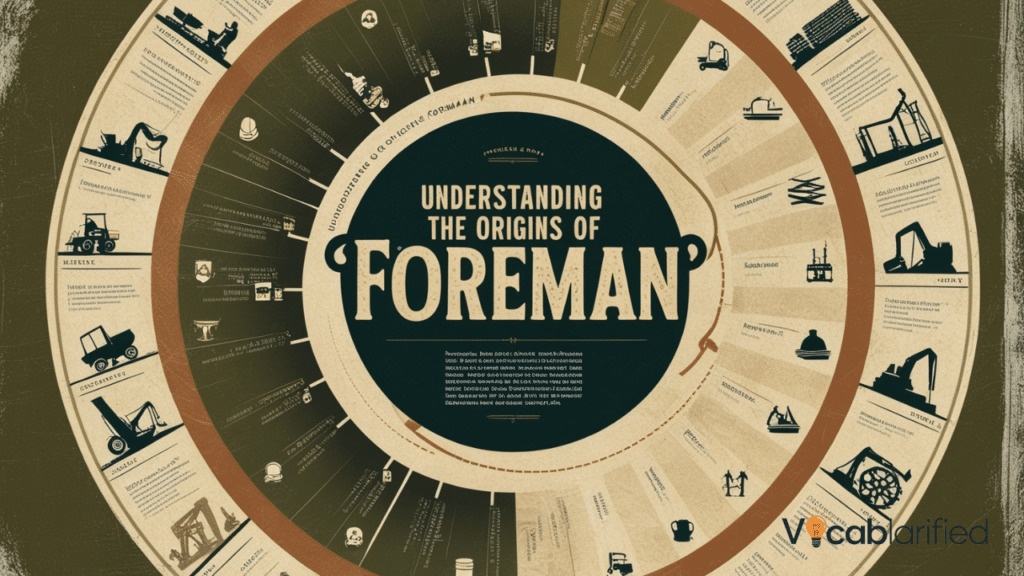In the realm of English grammar, few linguistic challenges are as intriguing as the plural forms of occupational titles. The word foreman stands out as a particularly fascinating example of the complexities inherent in linguistic patterns.
Construction sites, industrial settings, and professional environments frequently grapple with the question of how to correctly pluralize this term.
Origins of the Term Foreman
The word foreman historically originated from two distinct parts: fore meaning “front” or “leading,” and man, indicating a person in a supervisory role. This construction supervisor title has deep roots in workplace hierarchies, reflecting a traditional approach to defining leadership positions within various industries.

| Industry | Typical Foreman Role | Historical Context |
|---|---|---|
| Construction | Site Supervision | Overseeing building projects |
| Manufacturing | Production Management | Coordinating factory operations |
| Mining | Operational Oversight | Managing underground work teams |
| Shipping | Cargo Coordination | Supervising loading and unloading |
| Railroads | Crew Management | Directing train and maintenance crews |
| Automotive | Quality Control | Ensuring production standards |
| Agriculture | Farm Operations | Managing agricultural workforce |
| Logistics | Warehouse Supervision | Coordinating shipping and receiving |
| Printing | Press Operations | Managing printing equipment |
| Electrical | Technical Supervision | Overseeing electrical installations |
You Might Like: Vicious vs Viscous | Use Them Correctly in Writing
Exploring Plural Possibilities
When confronting the plural of foreman, language users encounter multiple potential approaches. The most traditional and grammatically recognized form is foremen, which follows an irregular plural pattern similar to words like “men” and “women”. However, modern usage has introduced alternative interpretations that challenge traditional linguistic conventions.
Grammatical Considerations
English grammar provides fascinating insights into the complexities of plural formations. Irregular plural forms often defy standard rules, creating nuanced challenges for writers and speakers. The term foreman represents a classic example of these linguistic exceptions, where the standard “add an s” rule does not automatically apply.
| Singular Term | Traditional Plural | Modern Variant |
|---|---|---|
| Foreman | Foremen | Foremans |
| Workman | Workmen | Workmans |
| Policeman | Policemen | Policemans |
| Businessman | Businessmen | Businessmans |
| Fireman | Firemen | Firemans |
Professional Communication Dynamics
Professional communication demands precision and clarity. The choice between foremen and foremans extends beyond mere grammatical correctness—it reflects an understanding of linguistic nuances and professional expectations. Supervisory roles require meticulous attention to detail, and language usage is no exception.
You Might Like: Appendices or plural of Appendix? Clarifying Usage
Gender-Neutral Considerations
Contemporary workplace communication increasingly emphasizes gender-neutral terms. The traditional foreman title itself presents challenges in inclusive language practices. Some organizations have shifted towards more neutral alternatives like “supervisor” or “team lead” to address evolving workplace communication standards.
Contextual Usage Scenarios
Understanding the contextual examples of foreman pluralization helps professionals navigate linguistic challenges. Different industries and regional contexts might exhibit varying preferences in terminology usage.
| Communication Context | Preferred Usage | Potential Implications |
|---|---|---|
| Formal Academic Writing | Foremen | Demonstrates linguistic precision |
| Construction Industry Reports | Foremen | Maintains traditional terminology |
| Corporate Email Communications | Foremen/Team Leads | Balances tradition and inclusivity |
| Legal Documentation | Foremen | Preserves historical language conventions |
| Technical Manuals | Supervisors | Emphasizes functional description |
| Union Communications | Foremen | Reflects established professional language |
| International Business Correspondence | Foremen | Maintains consistent global understanding |
| Human Resources Documents | Team Leads/Supervisors | Promotes gender-neutral language |
| Trade Publications | Foremen | Preserves industry-specific terminology |
| Professional Training Materials | Foremen/Supervisors | Offers linguistic flexibility |
You Might Like: Family’s or Families’ or Families? A Simple Guide
Email Scenario Demonstrations
Professional scenarios often highlight the language usage nuances surrounding foreman pluralization. Consider the following email excerpt demonstrating practical application:
Subject: Shift Supervision Update
Dear Management Team,
I’m writing to confirm that our foremen for the downtown construction project will be meeting next Tuesday to discuss project milestones. The site foremen from Williams Construction and Metro BuildCorp will coordinate their upcoming schedules.
Best regards,
Sarah Thompson
Project Coordination Manager
This example illustrates how professional communication naturally integrates the term while maintaining writing clarity.
Linguistic Evolution and Adaptation
Language continually adapts to societal changes. The plural of foreman reflects broader linguistic trends where traditional rules intersect with contemporary communication needs. While foremen remains grammatically preferred, practical usage increasingly demonstrates flexibility.
Navigating Linguistic Complexities
Common Mistakes in Terminology
Common mistakes in using the term foreman plague many professional settings. Writers and speakers often struggle with the nuanced language exceptions that define its plural form. The tendency to simply add an “s” creates misuse of terms that can compromise communication effectiveness.
| Mistake Type | Incorrect Usage | Correct Usage | Potential Consequence |
|---|---|---|---|
| Simple Pluralization | Foremans | Foremen | Reduced linguistic credibility |
| Inconsistent Application | Mixed usage | Consistent form | Confusion in documentation |
| Overly Literal Interpretation | Foreman’s | Foremen | Grammatical inaccuracy |
| Gender-Inappropriate Usage | Forewoman | Forewomen | Potential workplace discomfort |
| Informal Shortening | Forems | Foremen | Unprofessional communication |
| Regional Variation | Foresmen | Foremen | Geographical linguistic confusion |
| Written Communication Error | Forman | Foremen | Reduced professional clarity |
| Translation Misunderstanding | Direct translation errors | Contextual adaptation | Cross-cultural communication issues |
| Academic Writing Mistake | Inconsistent pluralization | Standardized form | Reduced scholarly credibility |
| Legal Documentation Error | Improper plural | Precise terminology | Potential interpretative challenges |
Historical Language Rules
Historical language rules provide fascinating insights into the evolution of occupational titles. The term foreman emerged from a deeply patriarchal workplace culture, reflecting historical power structures and professional hierarchies.
Linguistic Patterns in Professional Terminology
Linguistic patterns surrounding occupational titles reveal complex social and grammatical dynamics. The foreman title represents more than just a grammatical challenge—it embodies the intersection of language, profession, and social change.
| Linguistic Feature | Foreman Example | Broader Linguistic Implication |
|---|---|---|
| Irregular Pluralization | Foremen | Reflects complex linguistic heritage |
| Etymological Origins | Fore + Man | Reveals historical linguistic construction |
| Gender Implications | Male-centric term | Demonstrates linguistic gender bias |
| Professional Evolution | Changing usage | Illustrates language adaptability |
| Semantic Transformation | Broadening meaning | Shows linguistic flexibility |
| Cultural Contextual Shifts | Varying interpretations | Highlights language’s dynamic nature |
| Grammatical Complexity | Irregular formation | Demonstrates linguistic nuance |
| Professional Communication | Precise terminology | Reflects occupational linguistic needs |
| Language Standardization | Accepted plural forms | Shows linguistic governance |
| Semantic Precision | Specific occupational meaning | Demonstrates language specificity |
Professional Email Communication Examples
Email scenarios provide practical insights into the plural of foreman usage:
Subject: Weekly Supervisory Update
Dear Project Management Team,
Our site foremen have completed the preliminary assessment for the Henderson Project. The foremen from different departments will convene next week to discuss implementation strategies.
Regards,
Michael Rodriguez
Operations Director
Navigating Workplace Communication
Supervisory roles demand precise communication. The choice between foremen and foremans extends beyond grammatical correctness, reflecting professional sophistication and linguistic awareness.
Clarity in Writing Strategies
Writing clarity requires understanding subtle linguistic nuances. Professional communicators must navigate the delicate balance between traditional grammatical rules and contemporary language usage.
| Communication Strategy | Foreman Plural Approach | Effectiveness |
|---|---|---|
| Academic Precision | Strictly Foremen | High credibility |
| Corporate Flexibility | Context-dependent usage | Adaptable communication |
| Gender-Neutral Approach | Supervisors/Team Leads | Inclusive communication |
| Industry-Specific Terminology | Traditional Foremen | Sector-specific clarity |
| International Communication | Standardized Terminology | Global understanding |
| Legal Documentation | Precise Foremen | Maximum interpretative clarity |
| Technical Writing | Functional Description | Functional communication |
| Professional Training | Balanced Approach | Comprehensive understanding |
| Cross-Cultural Communication | Adaptive Terminology | Reduced misunderstandings |
| Scholarly Publication | Grammatically Precise | Academic rigor |
Contemporary Language Considerations
Terminology differences continue to evolve. Modern workplaces increasingly prioritize gender-neutral terms and inclusive language, challenging traditional occupational titles.
Final Linguistic Reflections
The plural of foreman represents more than a grammatical curiosity. It embodies the dynamic nature of language, reflecting broader social changes and professional communication needs.
Professionals must remain adaptable, understanding that language usage is not about rigid rules but about effective communication. Whether choosing foremen or exploring alternative expressions, the goal remains clear and precise communication.
Practical Recommendations
When using the term foreman, consider these practical guidelines:
- Prioritize communication effectiveness
- Understand contextual nuances
- Remain open to linguistic evolution
- Prioritize clarity over strict adherence to traditional rules
The journey of understanding the plural of foreman mirrors the broader linguistic landscape—complex, nuanced, and continuously evolving.

Emma Carter is an experienced blogger at Vocablarified. She enjoys helping people expand their vocabulary and improve their language skills. With a warm and approachable writing style, Emma makes learning new words fun and accessible. When she’s not writing, she loves reading books and discovering new phrases to share with her readers. Emma is passionate about making language learning an enjoyable journey for everyone.







